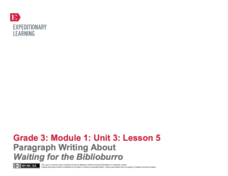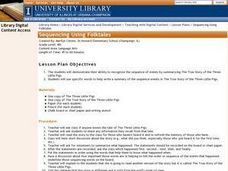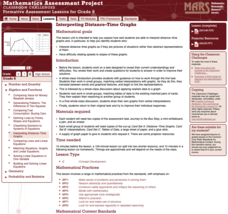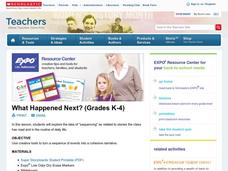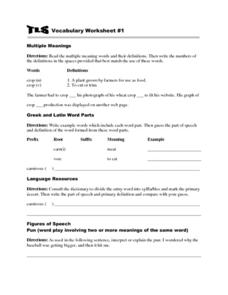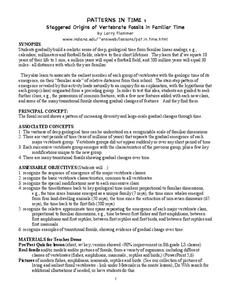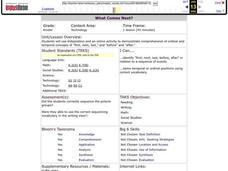Curated OER
Marking Time
Two narrative excerpts tell the same story from different points of view. In the first excerpt (first person), sequencing words and phrases are bolded and learners write down what the bold type does. The second excerpt is in third...
EngageNY
Paragraph Writing About Waiting for the Biblioburro
Ask your learners to synthesize what they know about Waiting for the Biblioburro by writing a well-organized paragraph. Young writers focus on using transition words and including specific details in their paragraphs. The plan allows for...
Curated OER
Compare Two Versions: Folk Tales, Sequencing, and Summary
Compare two versions of "The Three Little Pigs" (traditional and Jon Scieszka's The True Story of the Three Little Pigs, told from the wolf's point of view). As your 4th graders recount the familiar version of the story, emphasize the...
Curated OER
Transition Words in Writing
Transition words in writing are the focus of the language arts lesson presented here. In it, learners cut out the word-sort cards (embedded in the plan), and put them into four categories: time, examples, space, and summary. They find a...
Curated OER
In the Right Order
What comes first? Practice order of events with this sequencing activity. Learners examine two sets of pictures and write 1st, 2nd, and 3rd beneath the corresponding pictures. Encourage them to explain their reasoning, as there may be...
K5 Learning
Dessert Time!
First do this and then do that. Next do this and after do that. Young readers read about the order each person in the story gets dessert, before answering the who, the what, and the how in the reading passage.
Mathematics Assessment Project
Interpreting Distance–Time Graphs
Pre-algebra protégés critique a graph depicting Tom's trip to the bus stop. They work together to match descriptive cards to distance-time graph cards and data table cards, all of which are provided for you so you can make copies for...
Curated OER
Transitions
Give examples of transitions and why they are necessary in writing. A bit verbose, this handout is very thorough and provides many examples. The second page lists plenty of transitional phrases in a convenient chart.
Curated OER
Paragraph Development Exercise: Chronological Order
People use time to organize their days and structure their lives. Why not use it to structure a paragraph? Chronological order is logical and fairly straightforward. Ask class members to first read the provided example and then write...
Scholastic
What Happened Next? (Grades K-4)
Explore the structure of narrative writing with this fun, collaborative lesson plan. Start by reading aloud a short story, asking small groups of learners to fill in key events on a large story board prepared on the class whiteboard....
Curated OER
Sequence, Predict, Infer: Pink and Say
Practice sequencing with your 2nd graders via Patricia Polacco's Civil War book Pink and Say. Begin with a blindfold and a bag of mystery items. Connect their use of clues to identify what they can't see with the skill of making...
Curated OER
Creating Transitions
Fourth graders analyze the use of transitions in text. In this transitions lesson, 4th graders determine how and why a transition is used at a specific time in a piece of writing. They show transitions by using movements before...
Learn NC
A Christmas Carol Chronology
Which comes first? The Ghost of Christmas Past, Present, or Future? What clues can readers use to establish the chronology of A Christmas Carol? The tale of Ebenezer Scrooge, Marley, and Tiny Tim provides the text for an activity that...
Curated OER
The Use of Signal Words in Writing
Students examine the use of transition or signal word to create good paragraph organization.
Pennington Publishing
Vocabulary Worksheet #1 & #2
These two worksheets cover several grammatical topics. Pupils work on words with multiple meanings, Greek and Latin word parts, word connotations, academic language, and more. The result is seven quick exercises that could be used...
Curated OER
PATTERNS IN TIME
Students build a realistic sense of geological time, seek clues of transition fossils and find them. In this investigative lesson students complete several activities and worksheets on fossils.
Curated OER
Patterns In Time
Seventh graders examine fossils. In this vertebrate fossils lesson students view a demonstration.
Curated OER
What Comes Next?
Students use Kidspiration and on online activity to demonstrate comprehension of ordinal and temporal concepts of "first, next, last," and "before" and "after." They name temporal or ordinal positions using correct vocabulary.
Curated OER
The Correct Use of the Articles "A" and "An"
Students discover the grammatical rules regarding articles. In this grammar lesson, students study the rule regarding the use of "a" and "an" in writing. Students are encouraged to discover the rule on their own and apply the rule while...
Curated OER
Informative Speech Assignment
Allow your pupils to take on the role of the instructor with an informative speech that covers a new topic related to your unit of study or new information on a subject your class has already studied. Pupils fill out the provided outline...
Channel Islands Film
Eminent Domain
After viewing the documentary The Last Roundup, a documentary about the transitioning of Santa Rosa from a privately own island to a National Park, class members debate the takings clause of the Fifth Amendment that permits the...
Curated OER
Winter Syllables pg. 2
Come December, practice syllable counting with the appropriate time of year! Using the winter theme, readers identify the winter picture, clap the number of syllables, and place the correct number of cotton balls next to the four...
Illustrative Mathematics
Comparing Rational and Irrational Number
Algebra learners must know how to use rational numbers to approximate irrationals. This resource asks participants to decide which number is larger without using a calculator. It makes a great exercise to use as a five-minute transition...
Curated OER
The Rest Cure: Gender in Medicine and Literature
Read and discuss "The Yellow Wall-Paper" and the gender issues that the story brings up. Use articles from the time period to analyze, complete with specific discussion questions. After two days, scholars write an essay based on topics...



